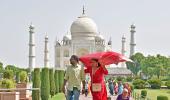'We can save 70 patients out of 100, if they reach a hospital well within time.'
'The most crucial aspect is time.'

On June 19, a record 17 people suffering extreme symptoms of a heatstroke, many of them unconscious, were brought in to Dr Amlendu Yadav's newly-established, specially-prepared heatstroke unit at the Ram Manohar Lohia Hospital, near Talkatora stadium, in New Delhi.
Another 15 to 20 were wheeled in lifeless, suspectedly from heatstroke too, triple the hospital's usual 'brought dead' rate.
At this unit, a part of RML Hospital's critical caredepartment, that Dr Yadav heads as professor, the heatstroke victims were quickly and unceremoniously dunked into ice baths to, as quickly as possible, lower the temperature of their internal organs and instantly revive them and save them from imminent death.

Each 300-litre ceramic tub, that takes two minutes to fill, requires 50-60 kg of ice to bring it to an optimum reviving temperature of 1-5 ° C (because the water is being piped in from overhead external storage tanks).
That reduces the patient's temperature -- which is being meticulously monitored, core temperature too, and he is also hooked up to a ventilator -- from the alarming and highly dangerous 105 to 110° F to 98.6 to100. 4° F, in abut 30-40 minutes.
S/he is then pulled out of the bath, so as to not allow shivering or the reverse of a heat stroke, hypothermia, to set in. And usually within 20 minutes the patient gained consciousness.
"That is the fastest way of bringing down the patient's temperature," explains Dr Yadav and other means, like say refrigerated/cold rooms or something else, would not do it that swiftly, because a cold-water tub has the maximum surface area impact.
He says the fact that they did not begin to shiver themoment their bodies reached normal temperatures was an unusual phenomenon and the positive result of careful supervision.
Most of the patients Dr Yadav saw on June 19, and the days preceding it, ever since the unit opened as per central government standards on May 8, fortuitously a few days before the heat wave, were from economically underprivileged backgrounds, usually the "bread earner of the family" and had journeyed in from a few kilometres away.
Had they ventured to this specially-equipped clinic at RML Hospital from longer distances, they would not have survived the journey, so "serious was their state."

Cases of heatstroke have been rising for some time in New Delhi, says Dr Yadav, as global warming causes summer mercury levels to shoot higher and higher, year on year, and the increasing concretisation of urban areas, like NCR, certainly does not help.
Studies have shown, according to Dr Yadav, readings closer to the tarmac of a road, and vehicular heat, are 15 degrees higher than the measured temperature of a place.
But this summer was particularly brutal in Delhi -- 48-49 C on some days -- with not even brief intermittent showers to break the spells of harshheat.
"We have seen an exponential rise in heatstroke cases this year. We have also seen an exponential rise in the number of cases which are coming as 'brought dead' too.
"Temperatures have gone to the extreme, because there were no rain spells, pre-monsoon showers in Delhi.
"More severe cases are presenting this year and definitely the number of cases is much more this year too."

The severer heatstroke cases had a slightly different clinical presentation as well.
Says Dr Yadav, "They are presenting in an extreme situation, extreme condition. Yes, with more damage (from the heat).
"They are coming with very high temperatures, ranging from 105 °F to 110 ° F, which is very high. Normal is usually 98.
"Most of them are actually presenting in an unconscious state. Some of them are also presenting with seizure disorders, because of the heat they are having convulsions, which is basically failure of the brain."
The cases labelled as 'brought dead' were likely from heat stroke too, because they came on days when the weather was impossibly sweltering, but only a postmortem could categorise them and would deem them suspected heat stroke deaths.
Casualties were considerably worse across the NCR because there was no awareness on what should be done if an individual was suffering a certain distinct and alarming collection of symptoms, in the face of such life-threatening heat.
The excessive temperatures also caused the symptoms to escalate significantly faster leading to unconsciousness and multiple-organ failure, especially when the victim did not move towards coolness or a hospital pronto.

Apart from the establishment of many more units like the one Dr Yadav is operating, raising awareness is the need of the hour too, he declares. That would save lives.
"We need to need to create awareness about heatstrokes for the laymen, especially to people belonging to the lower socioeconomic (strata), the daily wage workers and those working outside directly under the sun.
"We also need to modify our working conditions for these informal labourers."

Battling loo (the hot, dry wind of north Indian summers) and the baking sun are not new scenarios for Indians, who generally know how to keep themselves safe when summer temperatures skyrocket.
Rajasthan, as Dr Yadav points out, sees 55 ° C heat often in some areas. But they are prepared for it and know how to face it.
"Those people are very familiar with that kind of environment. They know the right precautions.
"Over a period of time, they have learned when to not go outside, what is to be taken and so on."
It was the sudden upswing of temperatures, taking them to levels of heat never experienced before in Delhi and areas nearby, and some other states, that lead to a drastic rise in heatstroke casesand fatalities.
"This was not the usual scenario in Delhi. Even in Odisha it started in the month of May.
"This year definitely the temperatures were very high and these people, (of low-income status), were not aware, they got caught unawares. Also, the weather changed very rapidly, sudden rapid rise of temperature."
Dr Yadav further clarifies that heat strokes are about a person being exposed toan abrupt change in environmental temperatures,that their body is not familiar with, that can change the scenario medically.
"By definition, it is basically if there is any rise of five to six degrees temperature, over and above the normal, for that time.
"So, heatstroke warnings were declared in London at even 26 °C. It's a comfortable range for Indians.
"Our AC runs at 26° C, but it was heatstroke weather for them at 26."
The effects of a heatstroke on the human body, and the outcome for a patient are poorer, the higher the temperature outside.
"Yes, they will have much worse symptoms. Yes, definitely their chance of surviving is also less."
But he further adds: "So if we talk about chances of survival, we have observed that there was a higher mortality in those cases that reporteda little late.
"If the gap between suffering the heatstroke and the time when they report to the hospital increases, chances of survival decreases.
"The important part is that if a heatstroke patient doesn't get treatment, there is an 80 per cent chance of dying.
"If the same heatstroke patient reported well within time, this mortality can be reduced to just 10 per cent.
"We can save 70 patients out of 100, if they reach a hospital well within time. The most crucial aspect is time. Because time is tissue."
In other words, the passing of time allows less tissue to be rescued. So 'time is life'.
 IMAGE: Dr Amlendu Yadav. Photograph: Kind courtesy Dr Amlendu Yadav
IMAGE: Dr Amlendu Yadav. Photograph: Kind courtesy Dr Amlendu YadavSetting up areas in hospitals to offer special heatstroke treatment has been on the government's agenda for many years now, but the actioning has been slow apparently.
Says Dr Yadav, "The ministry of health and family welfare have been preparing the documents for the last two or three years, and they have released it, with the guidelines this year.
"They directed the central government hospitals and hospitals all over India to set up facilities for heatstroke cases."
More and more heat wave cases began trickling into Dr Yadav's two-tub unit (there's a provision for an extra inflatable tub and beds in their new ICUs) in the first week of June and then there was a lull.
After June 15, the cases again picked up with June 19 being the worst day.
In this period, Dr Yadav says, his hospital saw about 50 cases of extreme heatstroke in all, andan uncountable 'brought dead'.
Delhi recorded officially 275 heatstroke deaths ('brought dead' will not make this count).
Excessive heat can have a radical effect on the body. Since much of our body is protein, like an egg, Dr Yadav describes, that is being boiled, the tissues of our body begin to sizzle and simmer in the sun.
"If I have to give an analogy, if we boil an egg, the protein gets denatured and the egg gets hardened.
"Similar things happen to our body when its temperature remains high for a longer duration.
"The enzymes -- which facilitate chemical reactions and metabolism in our body --become non-functional.
"Because of non-functionality of those enzymes, various organs, kidneys, lungs, heart, brain, also become non-functional and these organs go into failure.
"Such multi-organ failure patients are very difficult to be salvaged.
"A heatstroke in an extreme situation leads to failure of multiple organs, which leads to high mortality."
Folks in rural areas, far from urban centres, may not have access to better heatstroke treatment facilities, temperature management machines, or care.
Dr Yadav advises: "First and foremost is to bring that patient into ashaded area. Then sponge them with cold water.
"Give them cold water to drink. Place ice packs on body in the axilla (underarms), in the groin, across the abdomen.
"Even during transportation to the hospital, such measures should also be started at once.
"Cold IV fluid should be given... It will take more time, maybe two hours to bring the temperature down this way."
When temperatures are so high, the most prudent thing you can do is to not leave home and "modify your work profile."
In the event that you have togo out and are going to be exposed to heat, it's highly important to take these precautions, according to Dr Yadav:
- Keep hydrating yourself via water, ORS (oral rehydration solutions), neebupani, juices, fruits.
- Cover yourself, use an umbrella, wear a hat and light cotton clothing.
- Seek shaded areas all the time.

And how would you know a heat stroke is coming on?
"The common symptoms are they feel exhausted, malaise, headache. They feel like vomiting and also vomit.
"They can experience drowsiness, dizziness and have seizures.
"In an extreme situation their heart rate also increases.
"The body stops producing sweat. When the body stops producing sweat there is a high likelihood the patient will go into heat stroke.
"If the body is not able to control its own temperature and that mechanism is lost, that is the sign of a heatstroke.
Things have calmed down at Dr Yadav's RML unit after the rain last Friday, June 21 and there are no longer seeing victims of the heat or 'brought dead' from probable high-temperature causes, but it was a busy 44 days for the capital's first heatstroke clinic.
Public Health Advisory: Extreme Heat/Heatwave
Feature Presentation: Ashish Narsale/Rediff.com











 © 2025
© 2025